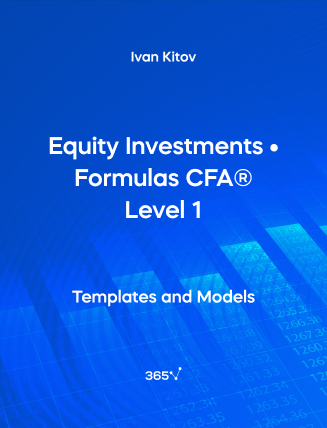Need an all-in-one list with the Equity Investments formulas included in the CFA Level 1 Exam? We have compiled them for you here. The relevant formulas have been organized and presented by chapter. In this section, we will cover the following topics — Market Organization and Structure, and Security Market Indexes.
1. Market Organization and Structure
Leverage ratio
Leverage~ratio = \frac {1}{Initial~Margin~Requirement}1 = 100%
Initial margin requirement = x%
Margin call price
Margin~call~price=P_0\bigg( \frac {1 - Initial~margin~requirement}{1 - Maintenance~margin~requirement} \bigg)P0 = Initial purchase price
2. Security Market Indexes
Value of price return index
V_{PRI} =\frac {\sum_{i=1}^N n_iP_i}{D}V_{PRI} = Value of the price return index
n_i = Number of units of constituent security i held in the index portfolio
N = Number of constituent securities in the index
P_i = Unit price of constituent security i
D = Value of the divisor
Price return of the index portfolio
PR_I = \frac {V_{PRI1} - V_{PRI0}}{V_{PRI0}}= \sum_{i=1}^N w_iPR_i= \sum_{i=1}^Nw_ i\Bigg( \frac {P_{i1} - P_{i0}}{P_{i0}} \Bigg)V_{PRI1} = Value of the price return index at the end of the period
V_{PRI0} = Value of the price return index at the beginning of the period
PR_i = Price return of constituent security i
N = Number of individual securities in the index
w_i = Weight of security i (the fraction of the index portfolio allocated to security i)
P_{i1} = Price of constituent security i at the end of the period
P_{i0} = Price of constituent security i at the beginning of the period
Total return of an index
TR_I = \frac {V_{PRI1} - V_{PRI0}+I}{V_{PRI0}}= \sum_{i=1}^N w_iTR_i= \sum_{i=1}^Nw_ i\Bigg( \frac {P_{1i} - P_{0i}+Inc_i}{P_{0i}} \Bigg)TR_I = Total return of the index portfolio
V_{PRI1} = Value of the price return index at the end of the period
V_{PRI0} = Value of the price return index at the beginning of the period
Inc_i = Total income (dividends and/or interest) from all securities in the index held over the period
TR_i = Total return of constituent security i
w_i = Weight of security i (the fraction of the index portfolio allocated to security i)
N = Number of securities in the index
Value of price return index (Multiple periods)
V_{PRIT} = V_{PRI0} (1 + PR_{I1})(1 + PR_{I2}) … (1 + PR_{IT})V_{PRI0} = Value of the price return index at inception
V_{PRIT} = Value of the price index at time t
PR_{IT} = Price return on the index over period t, t = 1, 2, …, T
Value of the total return index (Multiple periods)
V_{TRIT} = V_{TRI0} (1 + TR_{I1})(1 + TR_{I2}) … (1 + TR_{IT})V_{TRI0} = Value of the index at inception
V_{TRIT} = Value of the total return index at time t
TR_{IT} = Total return on the index over period t, t = 1, 2, …, T
Price weighting
w_i^P= \frac {P_i}{\sum_{i=1}^N P_i}w_i = Weight of security i
P_i = Share price of security i
N = Number of securities in the index
Equal weighting
w_i^E= \frac {1}{N}w_i = Weight of security i
N = Number of securities in the index
Market-capitalization weighting
w_i^M= \frac {Q_iP_i}{\sum_{j=1}^N Q_jP_j}w_i = Weight of security i
Q_i = Number of shares outstanding of security i
P_i = Share price of security i
N = Number of securities in the index
Float-adjusted market-capitalization weighting
w_i^M= \frac {f_iQ_iP_i}{\sum_{j=1}^N f_iQ_jP_j}f_i = Fraction of shares outstanding in the market float
w_i = Weight of security i
Q_i = Number of shares outstanding of security i
P_i = Share price of security i
N = Number of securities in the index
Fundamental weighting
w_i^F= \frac {F_i}{\sum_{j=1}^N F_j}w_i = Weight of security i
F_i = Fundamental size measure of company i
3. Fixed-income Securities
Conversion ratio
Conversion~ratio = \frac {Par~value}{Conversion~price}Conversion value
Conversion~value = Share~price \times Conversion~ratio
Conversion premium/discount
Conversion ~premium/discount=Convertible~bond~price - Conversion~value
4. Introduction to Fixed-income Valuation
Fixed-rate bonds
PV = \frac {PMT}{(1 + r)^1} + \frac {PMT}{(1 + r)^2}+…+ \frac {PMT+FV}{(1 + r)^N}PV = Present value (price)
PMT = Coupon payment amount per period
r = Discount rate
N = Number of periods to maturity
FV = Face value/par value/future value
PV = \frac {PMT}{(1 + Z_1)^1} + \frac {PMT}{(1 + Z_2)^2}+…+ \frac {PMT+FV}{(1 + Z_N)^N}PV = Present value (price)
PMT = Coupon payment amount per period
Z_n = Spot rate per period
N = Number of periods to maturity
FV = Face value/par value/future value
PVFlat = PVFull - AI
PVFull = \Bigg [\frac {PMT}{(1 + r)^{1-\frac {t}{T}}} + \frac {PMT}{(1 + r)^{2-\frac {t}{T}}}+…+ \frac {PMT}{(1 + r)^{N-\frac {t}{T}}} \Bigg ]PVFull = PV \times (1 + r)^{\frac {t}{T}}AI = \frac {t}{T} \times PMTPVFull = Full price of a bond
PVFlat = Flat price of a bond
AI = Accrued interest
PMT = Coupon payment amount per period
N = Number of periods to maturity
T = Number of days within a coupon payment period
t = Number of days from the last coupon payment to the settlement date
Fixed-rate bonds
\bigg( 1+\frac {APR_m}{m}\bigg)^m=\bigg( 1+\frac {APR_n}{n}\bigg)^nAPRm = Annual percentage rate for m
m = Periodicity that you are converting from
APRn = Annual percentage rate for n
n = Periodicity that you are converting to
Current yield
Current~yield = \frac {Total~PMT~in~a~year}{Flat~Price}Floating Rate Notes (FRNs)
PV=\frac { \frac {(Index + QM) \times FV}{m} }{ \Big(1+\frac {Index + DM}{m} \Big)^1} + \frac { \frac {(Index + QM) \times FV}{m} }{ \Big(1+\frac {Index + DM}{m} \Big)^2}+…+ \frac { \frac {(Index + QM) \times FV}{m}+FV }{ \Big(1+\frac {Index + DM}{m} \Big)^N}PV = Present value (price) of a floating-rate note
Index = Reference rate (stated as an annual percentage rate)
QM = Quoted margin (stated as an annual percentage rate)
FV = Future value paid at maturity (par value)
m = Periodicity of the floating- rate note, or the number of payment periods per year
DM = Discount/required margin (stated as an annual percentage rate)
N = Number of evenly spaced periods to maturity
Money market instruments
PV = FV \times \bigg ( 1-\frac {Days}{Year} \times DR \bigg )FV = PV + \bigg ( PV \times \frac {180}{365} \times AOR \bigg )PV = Present value (price) of the money market instrument
FV = Future value (face/par value) of the money market instrument
Days = Number of days between settlement and maturity
Year = Number of days in the year
DR = Discount rate (stated as an annual percentage rate)
AOR = Add-on rate (stated as an annual percentage rate)
Forward rates
(1 + Z_A)^A \times (1 + IFR_{A,B-A})^{B-A} = (1 + Z_B)^BZ_n = Spot rate
IFR = Implied forward rate
Follow the links to find more formulas on Quantitative Methods, Economics, Corporate Finance, Alternative Investments, Financial Reporting and Analysis, Portfolio Management, Fixed-Income Investments, and Derivatives, included in the CFA® Level 1 Exam.

